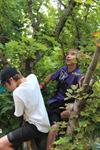 Learn to design playgrounds that are first and foremost functional and of value to children; but also aesthetic, safe, visually acceptable to the community and appropriate in all other ways.
Learn to design playgrounds that are first and foremost functional and of value to children; but also aesthetic, safe, visually acceptable to the community and appropriate in all other ways.
Safety is important of course. No one wants to put children in danger, but accidents do occur anywhere, and eliminating accidents can also restrict child development. This is one of many things that you learn to understand in this course. The following points should be taken into account:
- Give careful consideration to the design and build of a playground which obviously is not going to be maintained.
- Overcrowding of moving equipment (such as swings or seesaws) invites accidents.
- Consider the likely movement of children and avoid collision points (e.g. a swing should not move across the path along which children run. It may be necessary to put some fence or barrier around the swing).
- Give careful consideration to surfaces - an impact force of 500 (50 times the force of gravity) will have the potential to cause concussion in a child. The table below will give some guide to selecting the surfacing materials:
Good design will minimise risk of accidents; bad design will minimise opportunity for childhood experiences.
Course Structure
There are eight lessons in this unit as follows:
1. Overview of Parks & Playgrounds
2. 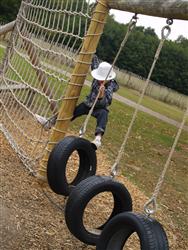 Playground Philosophy
Playground Philosophy
3. Preparing a Concept Plan
4. Materials
5. Park & Playground Structures and Materials
6. Local and Neighbourhood Parks
7. Community Participation In Park Development
8. Special Assignment.
COURSE AIMS
- Determine the procedure to plan a park development, including a playground and other facilities.
- Prepare a concept plan for a park or playground.
- Assess the design of park components, including materials and equipment used in parks and playgrounds.
- Determine appropriate design characteristics for a local or neighbourhood parks.
- Determine legal implications involved in the design of a playground.
- Design facilities to cater for movement throughout a park or playground.
- Manage appropriate community participation in development of a park or playground.
WHAT THE COURSE COVERS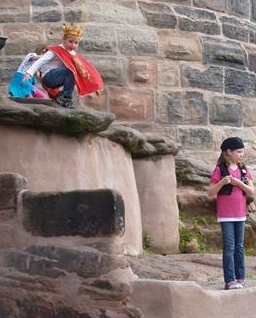
Here are just some of the things you will be doing:
- Explain how an understanding of play theory can be applied to the design of a playground.
- Explain how the concept of recreational planning may influence the design of a specified park.
- Determine factors which distinguish park design from home garden design.
- Compare different planning processes used for developing designs for public landscapes, including: advocacy planning, strategic planning and community participation.
- Explain historical influences upon park design, in your locality, including: *local history *national history.
- Evaluate the functional depreciation of a specified playground over a period of at least ten years.
- Explain the significance of demographic considerations on park design, in a specific locality.
- Evaluate the designs of two different established parks, and two established playgrounds, visited by you.
- Develop a brief for a park plan, through an interview with management of a specific site.
- Collect preplanning information for a proposed park design; through surveying the site and interviewing both managers of the site, and intended users of the site.
- Develop three alternative concept plans for a proposed park development; in accordance with a real design brief, either prepared by you with a client, or obtained as a brief for a job being put to tender.
- Compare three alternative concept plans in an interview with a client, or prospective client, for a proposed park development; recording the interview session on audio tape.
- Describe the design features of four different items of outdoor furniture intended for use in parks and playgrounds.
- Compare the suitability of different barriers, including bollards, fences, plantings and walls, used in three different parks and/or playgrounds; visited and inspected by you.
- Assess the design of garden constructions inspected by you in a children's playground.
- Compare various ground surfacing materials in terms of their application in park or playground design.
- Explain design considerations for earth forming, in a specific park and playground.
- Design a park plan for a specified site of 1,000 to 10,000 square metres, incorporating a themed play area.
- Prepare a costing for the construction of a themed play area, designed by you.
- Compare the appropriateness of fifteen different plants for use in a playground in terms of different factors including: -play possibilities -hardiness -toxicity.
- Determine appropriate design criteria for the use of water in playgrounds.
- Determine appropriate functions for neighbourhood parks.
- Determine inappropriate functions for a neighbourhood park.
- Analyse two neighbourhood parks by both; surveying users and observing users.
- Evaluate the design of two different neighbourhood parks, visited and studied by you, against different criteria including: *Function *Aesthetics *Maintenance requirement *Environmental sympathy.
- Recommend design modifications for a surveyed neighbourhood park.
- Explain the significance of danger to the children's learning experience.
- Determine how two different specific playground designs have been influenced by concerns about legal liability.
- Conduct a legal risk analysis of a playground which has been established for more than ten years.
- Develop guidelines for minimising legal liability in playground design, for an authority responsible for a specific playground.
- Determine design criteria for different types of trails in parks including: *Fun and fitness trails *Environmental interpretation trails *Cycle paths *Linkages between parks *Roadways.
- Compare the construction of three different specified paths within parks with reference to: *Durability *Safety *Function *Maintenance requirements.
- Prepare a concept plan for a "specialist trail" in a park, such as; a fun and fitness trail, a cycle path or an environmental interpretation trail, following design standards in the industry.
- Determine factors which impact on the success of a park/playground development which involves community participation.
- Analyse community attitudes to a park or playground development, which has used community participation, by either: * survey * discussion with local Parks Department management.
- Explain how to promote community involvement in park development in a way which will optimise the chance of success.
- Determine a procedure to involve a community in the development of a park/playground facility, on a site visited by you.
________________________________________________
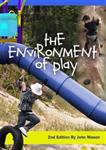 GOOD PLAYGROUND DESIGN STARTS BY FIRST UNDERSTANDING PLAY
GOOD PLAYGROUND DESIGN STARTS BY FIRST UNDERSTANDING PLAY
This is an extract from the ebook, The Environment of play, by our principal John Mason. published in 2011 by ACS Distance Education, first published by Leisure Press in New York, 1982. Available through our bookshop at www.acsebook.com
Play happens in all types of places, not just the playground. Perhaps the most useful exercise when considering this question is just to think over your own experiences:
Where did you play when you were a child?
What did you do when you played?
Do you still play, and if so where?
Some of the places where people play include: inside the home, in the home garden, in natural areas (such as the countryside, farmland, streams etc), on derelict sites (rubbish tips, demolished buildings, bomb sites etc), on roads or streets, in parks, in school grounds or on supervised playgrounds. There are, of course, many other play places not listed here.
The most popular places for play will naturally depend on the locality: what environments are available, what activities are preferred, and the suitability of the environments to particular activities. To maintain or improve play opportunities through the provision of appropriate environments, it is essential to know both:
What alternative play environments are available to people.
What type of play is likely to happen in those places.
TYPES OF PLAY
Even though our first thoughts of play might always focus on children, we should never forget that people of all ages play. Our major concern, however, throughout this book will be children's play.
Play begins at a very early age. Babies will grip, pull, or shake anything within reach - whether it be a rattle, a dummy, food or even their own hands. For a baby, play is very much a physical experience - an exercising or trying out of their muscles, or learning about the physical world about them. For the toddler, play retains this emphasis - learning about the capabilities and limitations of their own body. Play environments for babies or toddlers should provide a variety of opportunities to experience new activities and to confront new materials.
After the infant has mastered their ability to use their body, another dimension begins to grow in significance to the play activity – that of ‘social play.’ From the age of four or five, children increasingly play with each other rather than play alone. By playing together, children learn the ability to deal with relationships. A lack of proper opportunities for social play can lead to introverted adults who lack self-confidence in relationships with other people. Play environments should be developed in such a way as to enhance the opportunity for social interaction among children over the age of four.
Play can take an endless variety of forms which can be considered and classified in an almost endless variety of ways. Below is just one way of looking at different types of play:
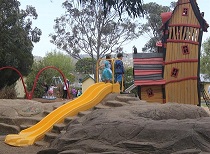 1) Physical Activity
1) Physical Activity
This could include such things as running, jumping, swinging, climbing, crawling, balancing, swimming, splashing, throwing, kicking, and so forth. This activity might be incorporated into a structured game or could perhaps be completely unstructured play. If an environment is being developed to be used exclusively for one particular type of play (e.g. a sports facility), it is possible to plan and build an area which is of optimum suitability for that activity. When an area is being developed to cater for multiple-play possibilities however, compromises often need to be made. It is usually desirable in planning a playground to maximise the number of different physical activities which can occur there.
2) Pretending
Sometimes called ‘role play,’ this type of activity forms a major part of children's play. Pretending involves acting out fantasies, playing in roles outside their real situation. Children pretend to be ‘grown ups’: parents in the work place, housewives, hunters, actors, policemen, or perhaps some character out of history or a fantasy world such as a space man, cowboy, Roman warrior or knight in shining armour. Usually, the roles children play change from day to day. This means that the play environment (which is in constant use by the same child) needs to be flexible and adaptable to a wide variety of roles (i.e. a cubby which can be a house one day and a fort the next day is far better than one which looks very much like a castle and wouldn't inspire the children to treat it as anything but a castle).
3) Creating or Constructing
To be able to make things is one of the most desirable forms of play. Unfortunately, this type of play usually requires at least some form of supervision. On supervised playgrounds or at home under the guidance of parents, children can become involved in craft-type activities. In the back garden or yard, on a supervised adventure playground or in derelict areas etc, children build cubbies. Where construction play can be introduced into an area, the environment comes alive, continually changing as old creations are destroyed and new ones are born. As the environment is continually changing, so the play possibilities also change. Children should never become bored and tired with such a facility.
There are innumerable possibilities for overlap between the three types of play outlined above. Usually construction play is also a type of pretend play (e.g. when a cubby is being built, it is going to be a fort, fire station, or hospital, etc). Often, pretend play involves at least some type of physical activity (e.g. Robin Hood swinging out of the trees, or cowboys running after the Indians).